How I Installed a Tankless Water Heater for My Off Grid Cabin
Everything You've Wanted To Know About Off Grid Hot Water And More
Here’s A Step-by-Step Guide To Selecting & Installing An On Demand Tankless Propane Hot Water Heater For Unlimited Hot Water Off Grid!

If you are living off the grid, you know how important it is to have a reliable and efficient source of hot water. You also know how challenging it can be to find the right water heater that suits your needs and budget. That’s why I decided to share my experience of installing a tankless water heater for my off grid cabin.
I live in a small cabin in the woods, far away from the grid. I love the simplicity and freedom of my lifestyle, but I also enjoy some modern comforts, like hot water. For a long time, I used a solar shower bag to heat water for washing dishes and bathing, but it was not very convenient or reliable. Sometimes, the sun was not strong enough to heat the water, or the bag would leak or burst. Other times, the water would be too hot or too cold, or run out before I finished.

I decided to look for a better solution, and I came across tankless water heaters. These are devices that heat water on demand, without storing it in a tank. They use propane or natural gas as fuel, and they are very efficient and compact. They can provide endless hot water at a consistent temperature, and they can be installed indoors or outdoors.

In this post, I will cover the following topics:
- Why I chose a tankless water heater over a traditional tank
- What type and model of tankless water heater I bought and why
- How I installed the tankless water heater and what challenges I faced
- What are the pros and cons of using a tankless water heater for off grid living
NOTE: This serves as a reference solely. Be sure to research and adhere to the rules, regulations and laws in your area.
Our hot water supplies the kitchen sink, bathroom sink as well as the shower.



Want Us To Show You Our Complete Cabin Build Instructions & Costs?
You can grab our complete floor plans, materials list, cost list and a step-by-step build list as a THANK YOU for just or dropping by and checking us out!
Why I Chose a Tankless Water Heater
A tankless water heater, also known as an on-demand water heater, is a device that heats water only when you need it. It does not store hot water in a tank, but instead uses a gas burner or an electric element to heat the water as it flows through the unit. This means that you can have unlimited hot water without wasting energy or space. Some systems like the one below can service a large off grid home and include expansion tanks to prevent water knocking and allow for very precise flow control.

There are many benefits of using a tankless water heater for off grid living, such as:
- Energy efficiency: A tankless water heater can save up to 50% of energy compared to a traditional tank water heater, according to The Trade Table1. This is because it only heats the water when you turn on the faucet, and does not waste energy by keeping the water hot in a tank. This also reduces your carbon footprint and your propane or electricity consumption.
- Space saving: A tankless water heater is much smaller and compact than a tank water heater, which can take up a lot of space in your cabin. A tankless water heater can be mounted on a wall, under a sink, or in a closet, depending on the type and model. This frees up more space for other purposes and makes your cabin look more spacious and tidy.
- Endless hot water: A tankless water heater can provide continuous hot water as long as you have enough fuel or power. You don’t have to worry about running out of hot water in the middle of a shower or washing dishes. You can also use multiple faucets at the same time without affecting the water pressure or temperature.
- Lower maintenance costs: A tankless water heater has fewer parts and components than a tank water heater, which means less wear and tear and less risk of leaks or corrosion. A tankless water heater can last up to 20 years with proper care and maintenance, while a tank water heater may need to be replaced every 10 years or less.
What Type and Model of Tankless Water Heater I Bought
There are different types and models of water heaters available on the market, such as propane, natural gas, electric, tank or tankless. Each type has its own advantages and disadvantages, depending on your energy source, climate, and personal preference.
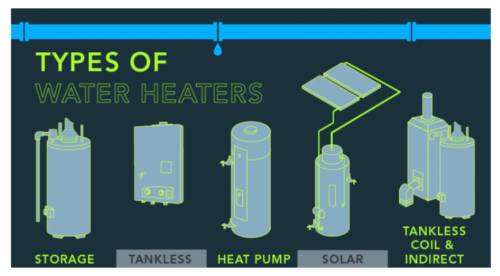
I decided to buy a propane-powered tankless water heater for my off grid cabin, because:
- Propane is more readily available and affordable than natural gas in my area
- Propane is cleaner and more eco-friendly than natural gas, as it produces less greenhouse gas emissions
- Propane is more reliable and consistent than electric, as it does not depend on solar panels or batteries
- Propane is more powerful and faster than electric, as it can heat the water to higher temperatures in less time
How do these tankless water heaters work anyway? Here’s a very simple diagram to show the internals workings of a typical tankless water heater.

The model of tankless water heater I bought is the Eccotemp L10 3.0 GPM LP Tankless Water Heater. Its a very compact and simple water heater.



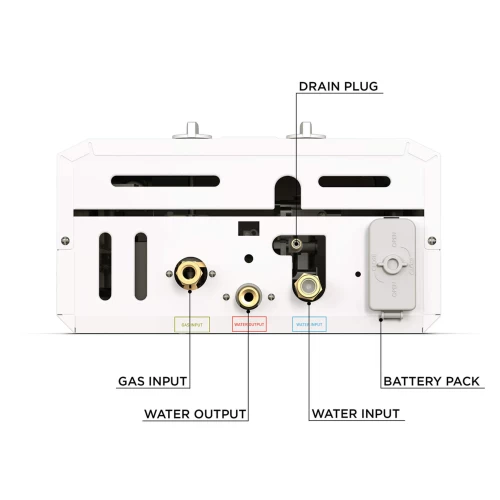
I chose this model because:
- It has a high flow rate of 3.0 gallons per minute, which can supply enough hot water for both the kitchen faucet and shower at the same time
- It has a low activation flow rate which means it can work with low-pressure or gravity-fed systems
- It has an outdoor installation design, which eliminates the need for venting or extra space inside the cabin. However, ours is installed in the bathroom with adequate and fire proof ventilation methods
- It has relatively small dimensions and fits very well in our bathroom
- It has two knobs for increasing/decreasing both the temp (gas flow) and water flow
- It is capable of reaching temperatures between 10 – 60 degrees Celsius
- The ideal operating range for the L10 is 20-80 PSI. We use a SHURflo 4008-101-E65 3.0 GPM Revolution Water Pump and an Accumulator Pressure Tank Water Pump Flow Control 0.75 L 125 PSI
How I Installed the Tankless Water Heater
Installing the tankless water heater was not too difficult, but it did require some planning and preparation. The best location for the water heater will be on the right side of the bathroom window.

During the plumbing phase I also created a water manifold out of PEX pipe, brass connectors/Tees/elbows and clamps and valves. Its located under the bathroom sink inside the vanity. I could isolate the kitchen sink, bathroom sink, shower and out door faucet independently. If there was an issue with one system I could close that value and and still use the other faucets (inside and out) as well as the shower.
This is the manifold I created which allows for isolating each system. I will be covering this in detail as well as the entire plumbing process in another post.

Here are the steps I followed during the tankless water heater install:
- I chose a suitable stable location for the tankless water heater inside the bathroom, on an outside wall and above our separett toilet. I made sure it was close to the propane tank(s) as well as the main water supply line. I also made sure it was properly secured to the wall studs and still had access to the shut offs and connections. I will enclose the shut off valves in a custom built box later.
- The water heater exhaust pipe runs through a special stainless steel air gap port that I made from metal flashing. I did this so that the HOT exhaust pipe does not come into contact with the drywall or the insulation at any point.

Above is the exhaust port hole on the exterior wall and below is the export I installed. The base of the exhaust port is a dryer vent block and the exhaust port itself is a metal dryer vent that also has a flapper inside to prevent cold air/birds/bugs from entering the cabin.


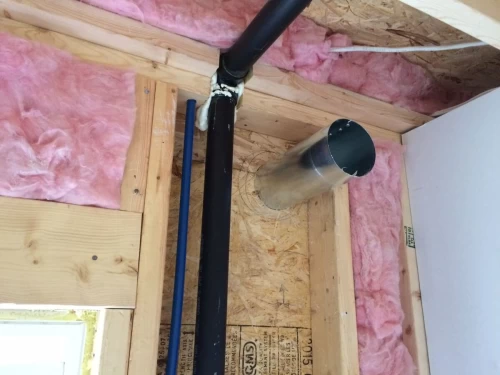

Below you can see the air gap between the inside hot pipe and the pipe that is in contact with the drywall/insulation.
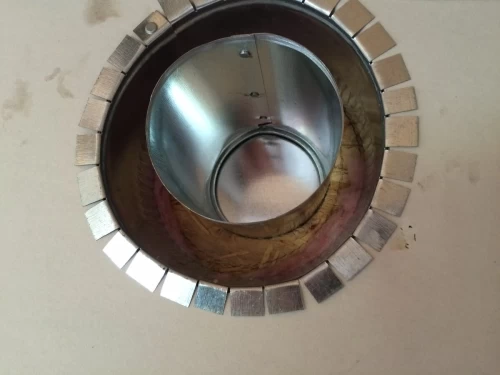




- Next the water supply line was connected to the tankless water heater using PEX pipe and fittings. As mentioned, I used the SHURflo 4008-101-E65 3.0 GPM Revolution Water Pump and an Accumulator Pressure Tank Water Pump Flow Control 0.75 L 125 PSI for optimal performance and control.
- I also installed a sediment filter on the lines that run from the outside rain barrels which you can read about in our How to Harvest RainWater for Off Grid Living: A Step-by-Step Guide.
- I then connected the propane gas line to the tankless water heater using flexible tube and brass fittings.
- I also applied pipe thread sealant and pipe dope to prevent leaks and corrosion.
- This particular water heater only uses two D-Cell batteries to operate the sparking device which ignites the gas.
- I turned on the propane gas valve and the water supply valve and checked for any leaks or problems. This is accomplished using a soap solution and a spray bottle to detect any gas leak. If any bubbles are detected you need to tighten or replaced any/all faulty connections. I also flushed the tankless water heater with cold water for a few minutes to remove any air or debris.
- I set the water flow to the maximum and temperature to the minimum. This produces the lowest temperature water. I tested the hot water flow and temperature at each faucet and the lowest setting was more than adequate for me. I also made sure to read the user manual and understand/follow the maintenance instructions. That’s something most people seldom do. Always READ the user/operating manuals of ALL your equipment.
So, What are the Pros and Cons of Using a Tankless Water Heater
After using the tankless water heater for several years now, I can say that I am very happy with my decision. A 30lbs tank of propane will easily last us 4-5 months. Having a tankless hot water heater, as opposed to heating up water in a pot or solar shower bag, has improved off grid living in many ways, such as:
- Saving money as its incredibly efficient on propane and ZERO electricity bills
- Saving me space in my cabin compared to the alternative of a tank water heater
- Providing me with unlimited hot water on demand all year long
- Reducing my environmental impact
However, there are also some drawbacks and challenges that come with using a tankless water heater, such as:
- Costing slightly more upfront than a tank water heater (but depends on the model of course)
- Requiring more installation work and expertise than a tank water heater
- Depending on the availability and quality of propane and water in your area
- Being affected by cold weather and high altitude
We also have a fresh water tank in our loft above the bathroom that we use in the winter to store water for showring and washing dishes. There is a simple crossover value I installed in the bathroom that allows us to switch between the water stored in the loft and the fresh water rain barrels outside. Again we have a complete article on how we harvest rain water and how our system was designed and built.

Some factors you may want to consider before buying a tankless on demand water heater for your home are:
- Cost vs Reliability: I wanted a water heater that was affordable but also durable and reliable. I read reviews and ratings from other customers and experts to compare different options.
- Power Availability: I needed a water heater that could run on propane, since I don’t have access to natural gas. I also needed one that could operate without electricity, or with minimal power from a battery or solar panel.
- Tank vs Tankless: I preferred a tankless water heater over a tank one, because it would save space and energy. A tank water heater would require more propane to keep the water hot all the time, and it would also be more prone to freezing or bursting in cold weather.
- Size vs Capacity: I wanted a water heater that was small enough to fit in my cabin, but also powerful enough to supply enough hot water for my needs. I calculated the flow rate and temperature rise that I needed based on the number of faucets and appliances that I would use at the same time, and the incoming water temperature in my area.
- Temperature Rise: This is the difference between the incoming water temperature and the desired output temperature. The higher the temperature rise, the more energy and time it takes to heat the water. For example, if the incoming water is 50°F and I want it to be 120°F, the temperature rise is 70°F.
- GPM (Gallons Per Minute): This is the amount of hot water that the water heater can deliver at a given temperature rise. The higher the GPM, the more faucets and appliances that can be used at the same time without losing pressure or temperature. For example, if the water heater can deliver 5 GPM at a 70°F temperature rise, it can supply enough hot water for two showers and a sink at the same time.
- Venting: This is the process of removing the exhaust gasses from the combustion of propane or natural gas. Venting is important for safety and efficiency reasons. Improper venting can cause carbon monoxide poisoning or fire hazards. There are different types of venting systems, such as direct vent, power vent, or atmospheric vent. Some water heaters require specific venting kits or accessories.
Conclusion
Having hot, fresh, instant and unlimited on demand hot water is one of the simple pleasures at our off grid home that was a critical components to making live out here so much more enjoyable.
Overall, I think that a tankless water heater is a great option for off grid living, as long as you do your research, choose the right type and model, install it properly, and maintain it regularly. A tankless water heater can make your off grid life more comfortable, convenient, and sustainable.



I hope this example of a blog post was helpful for you. If you have any questions or comments, please feel free to contact me. Thank you for reading!
Deep South Homestead did a great job of documenting a YouTube video of how he installed the same Eccotemp, L10 water heater we have. Have a watch and then feel free to browse the additional examples of other off gridders and homesteaders we know who have also chosen to add on demand hot water to their builds…
Here are some examples of blog posts that detail the research, purchasing, installation, and considerations for a tankless water heater for an off-grid home:
- The Best Off-Grid Water Heaters: 7 Efficient and Affordable Options: This blog post provides a comprehensive review of the best off-grid water heaters based on their purpose, energy source, and efficiency. It includes detailed insights to help you make the best decision for your needs. The top pick is the Rinnai V75iP Water Heater, which is a propane-powered, indoor tankless water heater1.
- Best Off-Grid Water Heater – Tiny House: This blog post discusses what an off-grid water heater means and the challenges of heating water when living off-grid. It compares electric and gas (specifically Liquid Propane) options for off-grid water heating2.
- Best Tankless Hot Water Heater for Off-Grid — The Trade Table: This article lists the best off-grid water heaters available on the market, including brands and models for off-grid hot water heating3.
- Best Propane Water Heater For Off Grid Cabin 2022 – Review & Buyer’s Guide: This guide provides in-depth information on the best propane tankless water heaters with no electricity4.
These posts cover various aspects such as personal needs, energy sources, geographical location, cost vs reliability, power availability (propane vs natural gas unit), tank vs tankless size vs capacity, temperature rise GPM (Gallons Per Minute), venting, and more12. They can provide valuable insights for anyone considering installing a tankless water heater in an off-grid home.
Your Turn...
P.S. If you enjoyed this post about How I Installed a Tankless Water Heater for My Off Grid Cabin then why not share it.
Share This Story, Choose Your Platform!
It’s how we keep growing our off grid community here and lets us know we’re posting the right kind of info you’re looking for.
Here’s a special Pinterest PIN for all our Pinterest fans out there!

Let us know what you think in the comment section below.
And be sure to join the rest of the off grid community here and follow along with the build of our cabin!
We’ll update the Building The Cabin section every time we complete a new phase of the build so be sure to check in and watch the progression.
how to clean solar panels
How to Clean Solar Panels: A Step-by-Step DIY Guide As you already know, residential and off-grid solar systems are amazing sources of renewable energy that are quickly growing in popularity. The large flat [...]
earthship
What Is an Earthship and How It Can Help Save the Planet Imagine living in a home that is completely self-sufficient, eco-friendly, and comfortable. A home that grows its own food, collects its [...]
3-way-switch-wiring
3-Way Switch Wiring: A How to Comprehensive Guide Here at the off grid cabin we’ve done our fair share of electrical work including 3-way switch wiring. We’ve done all the internal and external [...]
solar generator
How To Find The Best Solar Generator Impact-Site-Verification: c336f89e-c692-4afd-99d9-0150f7329466 When we first cleared the land to build our off grid home back in 2016, we started with one of those small 700 watt [...]
Off Grid Heating
The Best Off Grid Heating Methods Introduction To Off Grid Heating If you're Living off the grid already or planning to in the future, you already know how important it is to have [...]
off grid appliances
The Best Off Grid Appliances for Off Grid Living Introduction To Off Grid Appliances Living off the grid can be a rewarding and fulfilling experience, but it also comes with some challenges. One [...]



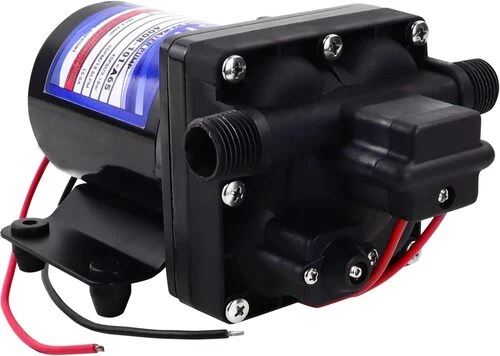






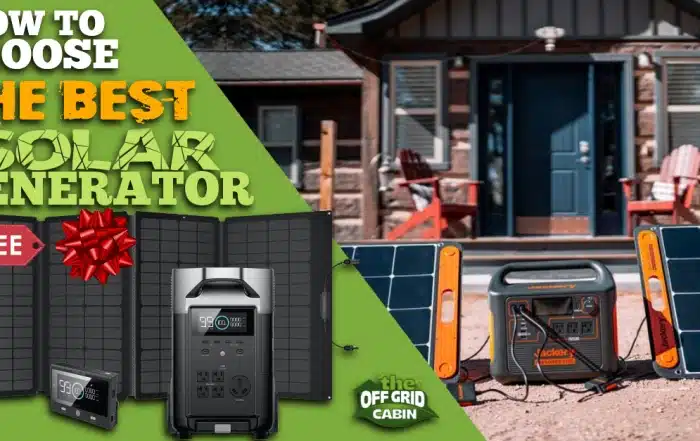











I really enjoyed your article on the tankless water heater.